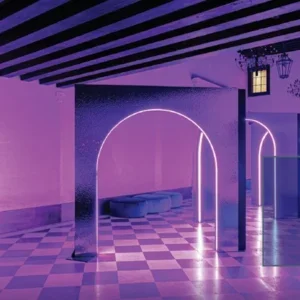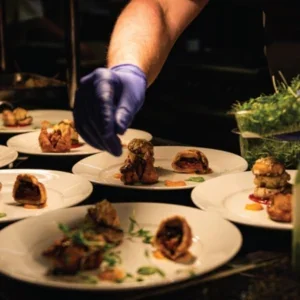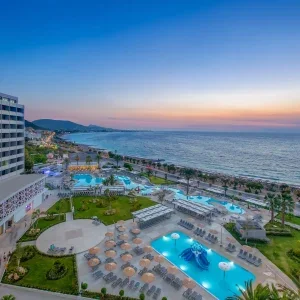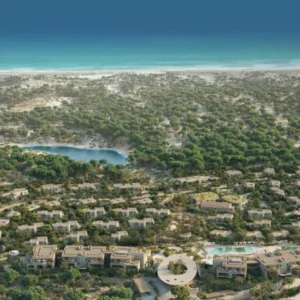When it opened soon after the revolution, the Nile Hilton announced the coming of a new Cairo. It was built, first of all, on the site of an old barracks – previously occupied by Egypt’s oppressors. Then there was the design, all smooth lines and steel and utilitarian staircases zigzagging up and down, the very epitome of the modern age. Inside was just the same. There were grand ballrooms with handsome frescos on the walls, and in the lobby, guests could sit and sip cocktails in fabric chairs. And when they were tired, they could retire to their rooms, with balconies that looked out to the Nile and on to the pyramids beyond.
None of this probably makes much sense, unless you understand which revolution I’m referring to. Not the ragged uprising of 2011, much less the ‘revolution’ of 2013, where Egypt’s military squashed a democratic government and killed hundreds. No, the Nile Hilton opened in 1959, seven years after the 1952 revolution when Egypt was giddily and irrepressibly optimistic. The barracks it replaced once hosted occupying British soldiers, and the country had just defeated a trio of foes in the Suez Crisis. Egypt was, in short, the nation of the moment. Little wonder that, in those heady days, Egyptians habitually proclaimed their country as umm al-dunya – the mother of the world. Since the violence of 2011, however, Egypt has faltered, and its tourism industry with it. Things have been even worse over the past year. Covid-19 has battered hospitality around the world, but in a country where millions directly work in tourism, where unemployment was already running at over 10%, the pandemic has been an even bigger disaster for the people by the Nile.
“Tourism [in Egypt] brought in $13bn and accounted for over 9% of GDP in 2019 – and then we had the pandemic.”
Kevin Graham, Oxford Business Group
$2.36bn
Tourism spending from GCC nations in Egypt in 2020.
Arabian Travel Market
1.25m
Egyptians directly employed as waiters, cleaners, tour guides and in hotel concierges.
Statista
That dire statistic sits in the shadow of the country’s broader challenges. A third of Egyptians live below the poverty line, after all, and roughly a quarter huddle in breezeblock slums. Not that the situation is hopeless. Spurred on by spectacular new archaeological finds that are making headlines the world over, the years ahead seem far brighter.
Tourism has been part of the Egyptian DNA for decades. In 2008, three years before the country’s most famous revolution, tourist numbers peaked at 12.8 million, and brought in over $10bn in revenue. And despite revolution and counterrevolution, economic sclerosis and political repression, these numbers have proved remarkably resilient – until recently anyway. In 2018, for instance, Egypt attracted 11.3 million visitors. Not that the importance of the country’s tourism industry can be measured in dollars or stamped passports alone. There’s also the benefits it brings to local people – 1.25 million are directly employed as waiters and cleaners and tour guides and in hotel concierges.
All this is scattered across Egypt like dust in a storm. There’s Sharm el-Sheikh and Hurghada, the big Red Sea resorts, as well as smaller seaside towns along the Mediterranean. There are dozens of hotels down the Nile, at Luxor and Aswan, where visitors come to see Ancient Egyptian tombs and temples. There’s even a boutique sector at Siwa in the Western Desert, where sophisticated travellers can hike among the dunes and sleep beneath the stars.
Deserted revenue
In short, then, tourism is as important to Egypt as the Nile itself – how else to explain its 300 major branded hotels, over 150 more than Morocco, its regional nearest rival? Yet, as Kevin Graham explains, this leaves Egypt deeply vulnerable when things go wrong – just as it did last year. “Tourism brought in $13bn and accounted for over 9% of GDP in 2019 – and then we had the pandemic,” says Graham, an editorial manager at the Oxford Business Group, a research company with offices in Cairo. “The expectation was that they might build on that, but in reality, just 3.5 million tourists came to Egypt [in 2020] – and tourism revenue fell by 70% to $4bn [across that year].”
Of course, Egypt is not alone here. Just like other tourist hotspots, it’s been hit by lockdowns and travel bans and occupancy limits. Yet one gets the sense that Egypt’s problems run deeper than the immediate struggles of the pandemic. One issue, suggests Amr Karim, general manager at Travco Travel, is security. As Karim notes, 2015 saw a collapse in the number of Russian tourists coming to Egypt after Islamists snuck a bomb on to a chartered flight returning to St Petersburg from Sharm el-Sheikh. That year also saw the death of 12 Mexican tourists after the security forces mistook them for terrorists. Then there’s Egypt’s creaking infrastructure. The last few months have already seen two fatal train crashes in the country, and its roads and airports leave much to be desired as well. Nor is the country’s battle against Covid-19 anywhere near over – around 98% of Egyptians have yet to receive a single vaccine dose at the time of writing.
If you visit a branded hotel in Cairo or Alexandria, you’ll be greeted just as you would in Paris or Berlin. Staff will wear masks, disinfect surfaces, keep their distance – and generally make your stay as safe and reassuring as possible. As Mark Willis suggests, that isn’t very surprising given the “clear challenges” of the pandemic. And as the CEO at Accor Middle East and Africa continues, that has mainly meant implementing Accor’s global Allsafe programme across its Egyptian portfolio: for instance taking customers’ temperatures, or limiting the number of people per table at hotel bars. Right now, over 90% of the French giant’s Egyptian properties have implemented Allsafe, with the remainder due to catch up soon.
It is clear, though, that implementing robust safety measures is only the most immediate way of reviving Egypt’s tourism industry. Like other brands, Accor is also embarking on a major investment scheme in the country. That starts along Egypt’s long coastlines.
“We have a strong pipeline in Egypt, which only reinforces our belief in the country as a destination, as well as a location to conduct business.”
Mark Willis, Accor
$13bn
Revenue that tourism brought to Egypt in 2019.
Central Bank of Egypt
$4bn
Revenue that tourism brought to Egypt in 2020. A fall of 70%.
Egypt’s Ministry of State of Antiquities
In March 2021, for instance, it opened the Rixos Premium Magawish, an elegant whitewashed property by the sea at Hurghada. It is shadowed by two more beach hotels, one in Sharm el-Sheikh, and the other at Ain Sokhna near Suez. Nor is Accor alone. Hilton, for example, has a pipeline of nine hotels planned for Egypt by 2026. Luxury brands are investing too, with Fairmont unveiling an extravagant Raffles on the banks of the Nile. Given wealthy travellers from the Gulf are increasingly flocking to the country – GCC tourism spending in Egypt reached over $2bn in 2020, according to Arabian Travel Market – this focus on glamour seems wise.
In part, this growth can be understood as simply building on Egypt’s deep foundations of hospitality. As Willis puts it, the country’s “comparatively well-developed” tourism infrastructure helps make Egypt an “even more attractive” destination for tourists. Maybe so – but the Egyptian government deserves credit too. Both Graham and Karim highlight the improved security situation post-2015, with Karim noting that flights between Russia and Sharm el-Sheikh were recently restored after the disaster six years ago. New infrastructure is helping too. The Abdel Fattah el-Sisi government plans to expand Egypt’s road network to 30,000km – up from 23,000km – with swanky new Russian railway carriages in the works too. Apart from making the country more tempting to would-be investors, Graham also emphasises that all this makes Egypt more attractive for visitors. To prove his point, he describes travelling around Cairo by car. Despite the city’s infamous traffic jams, he says that journeys that once took three hours can now, mercifully, be completed in one.
Ancient history now
Earlier this year, Egyptians were treated to an unusual sight. Nearly two dozen mummies – 18 kings and four queens – were solemnly paraded through downtown Cairo in special cars. The vehicles, decked out in hieroglyphs and painted gold, were designed to look like the funeral rafts the mummies had taken on what they had hoped would be their final journey. The whole spectacle was televised on Egyptian TV, and people even had the chance to show their passion via a filter on Facebook. And what was all this for? The mummies were travelling over the Nile to the Grand Egyptian Museum, a spectacular $795m palace of glass and steel near the pyramids at Giza.
Egypt’s glorious past has been having a moment – and those funeral rafts are just the start. In April this year, archaeologists uncovered a huge pharaonic city near Luxor, with ancient ovens and utensils still visible even after 30 centuries. For Dr Zahi Hawass, Egypt’s most famous archaeologist and the man responsible for the find, the practical benefits of the discovery are obvious. “We hope that after Covid-19,” he explains, “we can really have a lot of tourists – who already recognise the importance of Egypt as a destination.”
Between the new hotels, the new infrastructure and the spectacular new archaeological discoveries, it would be fair to assume that Egypt’s tourism industry is back on track after a decade of wobbles. That’s certainly what industry insiders think anyway. “We have a strong pipeline in Egypt, which only reinforces our belief in the country as a destination, as well as a location to conduct business,” emphasises Willis. “We look forward to continue being one of the main hospitality management companies in the country, as we expand our offering and portfolio.” The mother of the world may be tired after years of exertions – but you’d be foolish to count her out just yet.






